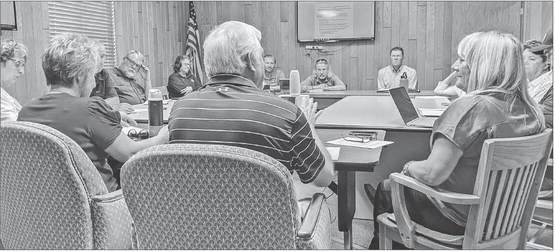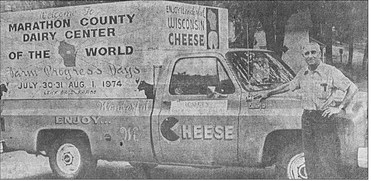Assemblies ordinance pulled
By Kevin O’Brien
A proposed ordinance that would regulate large public gatherings in Marathon County’s rural townships was pulled from Tuesday’s county board agenda and referred back to a trio of committees for further discussion.
Board chairman Kurt Gibbs announced at the board’s educational meeting last week that the heads of the Public Safety and Infrastructure committees — which initially recommended adoption of the new ordinance – had asked him to refer the proposal back to the committees so more work can be done. The Environmental Resources Committee, which never made a recommendation to adopt the ordinance, will also get another opportunity to discuss the issue before it goes before the board.
Gibbs did not identify any specific issues the committees would be looking into, but three members of the public raised concerns about the impact of the ordinance as proposed.
Greg Szemborski, president of the North Central WI Antique Steam and Gas Engine See ASSEMBLIES/ page 2 Assemblies
Continued from page 1
Club, questioned a couple of provisions in the ordinance that would affect the Edgar Steam Show, which is one of the only existing events that would fall under the ordinance due its crowd size. (The ordinance will also likely apply to The Taste & Glow Balloon Show in the town of Stettin. Organizers recently announced that the event will be held this year despite earlier doubts).
First, Szemborski pointed to a section requiring event organizers to provide a list of the names and addresses of all adjacent property owners within 2,640 feet of the event grounds.
“Well, I look at that and think ‘If the county wants to know who our neighbors are, all they have to do is consult a plat book,’” he said. “Why should our club have to provide the county with all of the neighbors? I would think that would be common knowledge.”
Another of Szemborski’s concerns is a hold-harmless provision that requires the event organizers to sign an agreement that all county employees and representatives would be immune from liability resulting from granting the assemblies permit.
“That, to me, doesn’t make sense,” he said. “Why do we as a club have to sign off on anything that Marathon County employees have to do?”
Bernie Kramer of Kronenwetter said he’s been going to the Edgar Steam Show for 50 years and spoke highly of the event’s various activities to draw people in, such as the large outdoor market and the live music performances. He also noted that the organizers have “done a heck of a job” of moving off of CTH N, which used to be a source of problems for pedestrians and vehicles going in and out of the event grounds.
“There’s been such good traffic control by these volunteers, it’s been extraordinary,” he said. “They do such a good job.”
Kramer urged the board not to wait for a proposed one-year review to see if the ordinance is working correctly, but to have event organizers and county representatives hash out the details before it is adopted.
“If you’re going to do it up, do it up right the first time, and take time to do it,” he said. “I think everybody would be happier, and that’s the important thing: keep everybody with a smile on their face.”
Dean Beck, town of Easton chairman, told supervisors he’s concerned by what he sees as the lack of town input in the event application process. County officials have said that the township where an event is proposed will be notified as soon as an application is submitted, and the ordinance also gives townships the opportunity to appeal the county’s decision to grant a license.
However, Beck did not think the five-day appeal period is an adequate way of involving the townships in the permitting process.
“I think it’s a little backwards,” he said. “I’m the first phone call for people, and I don’t like it when I don’t have answers.”
Beck also relayed concerns from his local fire chief, who is worried about the rural fire department’s ability to handle gatherings of 3,000 people or more. He also took issue with a provision in the ordinance that allows outdoor activities to take place from 6 a.m. to 2 a.m., with only a four-hour break, saying that’s not enough quiet time for township residents.
Easton’s town board has already set tighter time limits for the indoor Q& Z Expo, which must end its performances at midnight on weekends and 11 p.m. on weekdays, he said. The township also does not allow outdoor music or consumption of alcohol outside, so Beck wondered if town ordinances would be overridden by the county’s ordinance.
“I’m not opposed to outdoor events, but I just want some reassurance that this stuff will be considered,” he said.
Later in the meeting, corporation counsel Mike Puerner said the proposed ordinance does not require local municipalities to provide additional public services, but it does allow event organizers to enter into a contract with the county for additional sheriff’s deputies or traffic control.
Conservation, Planning and Zoning (CPZ) will be in charge of enforcing the ordinance and reviewing applications from event organizers, along with representatives of other county departments. CPZ director Laurie Miskimins said her department’s goal is not to look for excuses to issue citations, but to help people organize safe and successful events that respect the rights of neighboring landowners.
A work group consisting of representatives from CPZ and several other departments met for months to address several issues with the ordinance, and it also reached out to local townships and event organizers for their input.
“We’re creating an ordinance that can be a planning tool for events that might come to our county,” Miskimins said.
County administrator Lance Leonhard said the conversation about developing a new assemblies ordinance started years ago when it was determined that the county’s existing ordinance, 12.04, faced constitutional questions related to citizens’ rights to peaceably assemble and was also outdated.
Leonhard said the work group has delivered its ideas for how to change the ordinance, but “more work needs to be done,” either by the work group or the three committees involved in the discussions. Ultimately, he said it’s up to supervisors to decide how much, if at all, they want to set rules for large assemblies.
“If you choose not to regulate in that area, that is a policy decision you have,” he said. “You can do so by striking the ordinance.”



